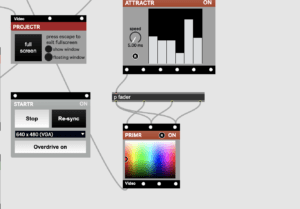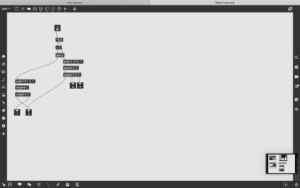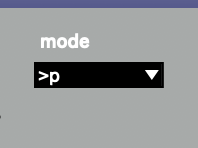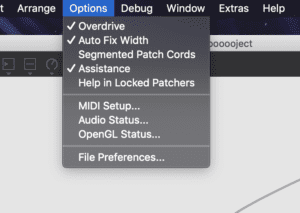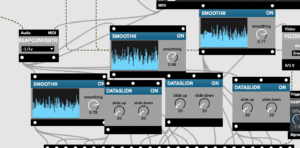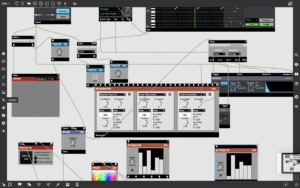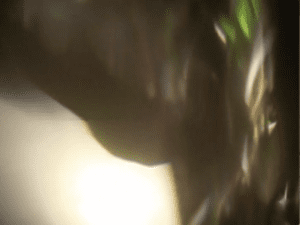Title
Butterfly Lovers
Project Abstract
By combining the physical device and digital effect from Max, our project tries to interpret Butterfly Lovers in a new way.
Project Description
Our project tells a traditional Chinese love story called Liangzhu (Butterfly Lovers). We use the original piano song Liangzhu played by the piano and the flute as the basic background music, and the blooming process of a flower to represent the love. The story happened in the East Jin Dynasty when the feudal thought was still strong. Pretending to be a male, Zhu Yingtai met Liang Shanbo on the way to school. They spent a few years together and both fell in love. However, Zhu was from a wealthy family and her father arranged her marriage with a rich man. Liang, who was a poor man died of disease of grief. On the way to her marriage, Zhu leaves the procession to pay her respects at Liang’s grave. She descends in bitter despair and begs for the grave to open up. Suddenly, the grave opens with a clap of thunder. Without further hesitation, Zhu threw herself into the grave to join Liang. Their spirits emerge in the form of a pair of butterflies and fly away together, never to be separated again.
Our very first intention was to express a story like this since we are both familiar with the piano song of Butterfly Lovers, and this becomes one of the reasons why we wanted to present this story. Also inspired by the performance PANORAMICA 2011, we think to change different cut patterns (laser cut or paper cutting) to produce variable shadows is an amazing way to perform. Therefore, we decided to make shadows as the primary way of the performance, including the shapes of circles, lightings, waves, and rectangles.
Perspective and Context
“[Light] is part of the universe of flux,” Wilfred said in the same interview, “and therefore motion is a necessary dimension, in fact, in any visual art involving light.” The small torchlight lying on a pile of books during the performance was indeed the most important thing. The light is the center of our whole performance and all the things that happened surround the light. The light went through the moving laser cut board and produce different kinds, layers of shadow. What’s more, we chose to use the partially reflective paper and stick them inside our laser cut frame, to produce the Lumia effect as Wilfred has described, also as the effect is shown in the LUMIA documentary (00:48). Combining the Lumia effect with the blooming of the flower endowed the performance with a feeling of the flower blooming in the universe of flux.
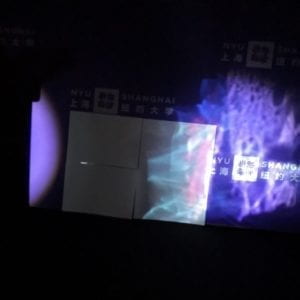
Lumia effect from the reflective paper
Development & Technical Implementation
From the very beginning, we decided to use laser cut to achieve the physical part of the performance device, so our development of the project is mainly divided into two parts: the physical laser-cut part and the effective treatment on Max. For our final setup, we have the physical device between the light source and the projection on the white paper. We have different patterns and components laser cut, for example, 3 parts of the flower, the butterflies, the bird, and four different patterns. On Max, we will change the mute mode of different parts of music during the progress, from rain sound, twitter sound, aeolian bells sound to the sound of thunder. Meanwhile, with the going of the story and music, adjust the effects like delayer, rotator, and Zoomer. Besides the physical part and digital part, we also consider other effects, for instance, the change of light color, to produce the Lumia effect and the use of smoke (dry ice) during the process. Therefore, we used partially reflective paper and paper that is reflective. As for how we developed the performance device, the interactions between us and the device are also divided into physical and digital parts. Based on the background music and the continuous promotion of the story, the projection and add of outsource music (e.g. the thunder) echo with the story plot. For example, when the basic layer of the song, the piano Liangzhu goes into the strongest part, we will add the sound of thunder sound, the video produced by EASEMAPPR will be a source of the final video since it will make the video flash quickly, while the laser cut board with lighting shapes in the front of the light source.



Design of the whole project/ physical part




Final setup: flower component, frame, and effect of using partially reflective paper
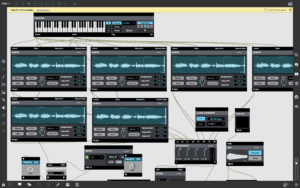
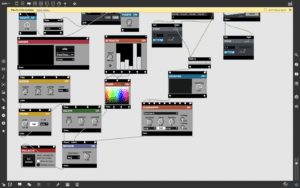
Screenshot of our patch
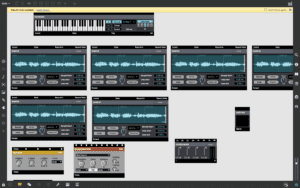
Screenshot of the presentation mode
We also met some other problems. During the rehearsal, we found the shadow of the frame was annoying so we cut the board off. Moreover, our initial light source was some small LED lights, but their lights are too weak and hard to be controlled. We then borrowed the video light, but it contains a lot of LEDs so the shadow will be ambiguous. After that we tested the phone torchlight, the effect is good but the phone is hard to be fixed on the ground. We bought a torchlight from eleme but it also contains 6 little LEDs in it, so the result is the same as the video light. Our final light resource is the torchlight that contains only 1 light in it borrowed from another group.

Cutting off the board

We bought a torchlight but sadly it is useless
For individual contributions, I am mainly responsible for the physical part. After testing the prototype of flowers and its shadow effect, I drew the draft of how flowers and the device frame will look like and turn them into ai file. One of the difficulties I have met is that the width of the petal contour is too small, so the laser may cause it to break directly. This also happened when cutting the wings of the butterflies.


Prototyping with paper




Screenshots of the design of flower



Adjusting and testing the width of petal contour





Final Production from laser cut and their effects
I have also tested different distance of the track on the frame, when the position of the track on the left and right side was too low, the lower part of the board was super easy to be broken. I also contributed to the built of Max, when testing the visual effects, we found out several best effects that do not destroy the original video, also to use PRIMR instead of changing colorful pieces of paper in front of the light source.
Performance
The final performance generally went well despite a few problems. However, during the performance based on my personal experience, it was a bit hectic. Since we only have two people and Tina is responsible for the MAX MID, I have to be responsible for all the changes in the physical device and the torchlight. One thing that really could go better is that we should have adjusted the distance between the camera and the wall so the NYU Shanghai wallpaper won’t be taken into the camera and the video would be much cleaner and purer. Another problem is that when I move the flowers on the track, due to its instability, the flowers were easy to fall out of the track, so before our final performance we asked Ellen for help. What’s more, since I was looking at the smaller television on the ground and there might be some reflections on the screen, so what I saw most of the time is really dark and in a mess, so I was really anxious and worried, while Tina told me later that it was fine and the Lumia effect can also be seen according to the audience, which was out of my expectation.
Conclusion
Personally speaking, the most difficult part of the project is the research and design part, since we spent almost a whole week on it. At the same time when we wanted it to look great, we also had to make sure that it is achievable. However, the process is really meaningful. We not only learned how to produce a fantastic video with the effects on Max and to control and adjust Max on a physical controller but also how to figure out the best relationships between the story and the music, like when to add proper background music, also between the music and visual effects. But as Eric has pointed out, we failed to go further on the exploration of effect. Since we put too much effort into the built of the physical devices, we are tied too tightly with it, thus ignore to further discover the effects. The Eyeball from the first group gave me a lot of inspiration on the use of different visual effects and a better combination of video and audio. We built a pretty good shadow, but need improvements on the effects.
